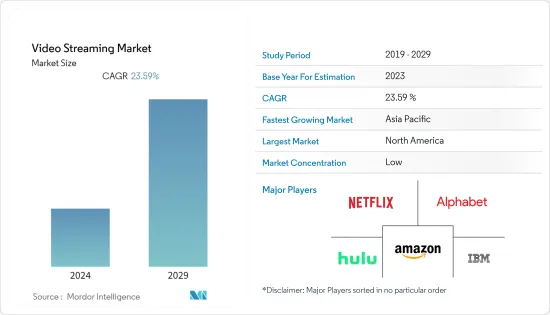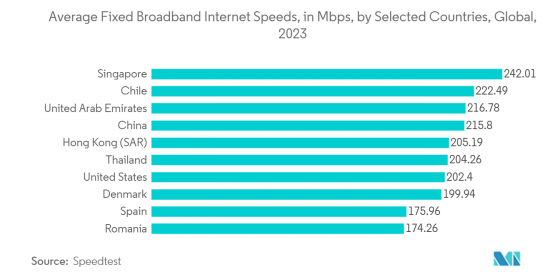PUBLISHER: Mordor Intelligence | PRODUCT CODE: 1408397

PUBLISHER: Mordor Intelligence | PRODUCT CODE: 1408397
Video Streaming - Market Share Analysis, Industry Trends & Statistics, Growth Forecasts 2024 - 2029

The Video Streaming Market size is estimated at USD 105.09 billion in the current year. It is expected to reach USD 303.05 billion in five years, registering a CAGR of 23.59% during the forecast period. The increasing recognition of OTT platforms, providing on-demand video content without the necessity for conventional cable or satellite subscriptions, might account for significant market growth. Moreover, OTT platforms were expected to draw more subscribers, especially among younger audiences pursuing flexible and personalized content consumption in the coming years to drive future market growth.
Key Highlights
- The video streaming market has grown significantly, transforming people's entertainment and data utilization. Video streaming is a real-time delivery of digital video content over the web, authorizing users to watch movies, watch recordings, live events, TV shows, and other visual content on different internet-connected gadgets without conventional physical media.
- The large availability of high-speed internet can be a driving force for the streaming video marketplace. Consumers can quickly get the right of entry to and stream video content to their smartphones, PCs, smart TVs, and tablets due to the vast use of broadband and mobile internet. This availability will increase demand for content material, while viewers can see shows and films favored on any tool at any time.
- Furthermore, the increase of these internet connections, particularly in cities and towns, has made streaming video less challenging to get suitable access to as more significant conditions' advantage of the substantial net infrastructure and a convenient target audience for streaming video sports keeps making bigger the marketplace growth. In addition, the huge adoption of smartphones, tablets, smart TVs, and other data-enabled gadgets has fueled the increase of video streaming.
- However, video streaming platforms might face challenges related to content piracy and unauthorized distribution of copyrighted material. Piracy affects the revenues of streaming services and content creators' earnings, thereby restraining market growth.
- Further, COVID-19 positively impacted the video streaming market. The lockdowns allowed people to explore and engage with a broader range of content available on streaming platforms. Users discovered new shows, movies, and genres during this period. Moreover, according to the IBEF, between January and July 2020, the number of paid subscriptions in the over-the-top industry increased by 30%, from over 21-29 million. Furthermore, urban areas had the most significant percentage of OTT video platform users.
Video Streaming Market Trends
Growing Availability of High-speed Internet Connections
- The rise in global penetration of broadband internet is one of the primary reasons for the surge in video streaming. Broadband infrastructure has increased substantially, increasing internet connections to a more significant population. As more households and regions access stable and fast internet, the potential audience for video streaming services has expanded, leading to a more extensive customer base for streaming platforms.
- Moreover, according to a recent survey by Speedtest, Singapore was recorded to be the fastest average fixed broadband internet speed as of April 2023, at 242 Mbps. The United Arab Emirates came in third with an average fixed broadband internet speed of about 217 Mbps, whereas Chile ranked second with more than 222 Mbps. Such significant internet speeds would have considerably contributed to the increased adoption of video streaming platforms.
- A high-speed Internet connection can allow users to watch streaming videos on various devices, including smartphones, tablets, computers, and smart TVs. The availability of high-speed Internet through mobile devices has simplified the use of mobile phones and allowed users to watch their favorite content anytime, anywhere, increasing convenience and collaboration.
- Additionally, high-speed Internet connections have enabled seamless delivery of high-quality video content. Video streaming platforms can now offer high definition (HD) and 4K content, giving viewers a more immersive and entertaining experience. Due to faster internet speeds, buffering issues are reduced, and users can enjoy uninterrupted playback, increasing their overall satisfaction with the streaming service.
- Adopting high-speed Internet connections has also led to live streaming, where users can watch events, sports, concerts, and gaming competitions in real-time. Live streaming has gained immense popularity due to the improved internet infrastructure that gives users a unique and interactive experience and fosters a sense of community among viewers.
- Further, high-speed Internet has enabled the growth of over-the-top (OTT) platforms that deliver video content directly to users without subscribing to traditional cable or satellite television. The availability of high-speed Internet connections has made it easier for viewers to leverage the cordless benefits and opt for OTT services, leading to a significant shift in consumer behavior and preferences.

North America is Expected to Hold a Significant Market Share
- North America has some of the largest streaming platforms globally. Companies like Netflix, Amazon Prime Video, Hulu, Disney+, HBO Max, and YouTube have established a strong presence in the region, offering subscribers a diverse and extensive library of content. These platforms have invested heavily in original content production to attract and retain viewers, leading to a competitive and thriving streaming market.
- The region's tech-savvy population and cultural acceptance of digital innovations have further fueled the adoption of video streaming services. North Americans readily embrace new digital trends, and the convenience of on-demand content consumption has driven a significant shift from traditional television to video streaming platforms.
- Moreover, the COVID-19 pandemic accelerated the growth of video streaming in North America. Lockdowns and stay-at-home orders led to a surge in demand for at-home entertainment, driving increased viewership and new subscriptions to streaming services. The pandemic highlighted the importance of digital entertainment and solidified the position of video streaming as a primary source of entertainment for many North Americans.
- Another factor contributing to North America's significant market share is the region's extensive and varied content offerings. Streaming platforms in North America cater to diverse audiences, providing content in multiple languages and genres. The availability of localized content has played a crucial role in attracting and retaining subscribers across different demographics.
- Further, streaming platforms in the region are anticipated to continue adapting to changing consumer preferences and evolving market dynamics to maintain their prominent position and grow in the highly competitive video streaming landscape.
Video Streaming Industry Overview
The Video Streaming Market is expected to be highly competitive due to global firms competing in various solutions and service offerings. In addition, these firms are actively engaging in partnerships and innovations to stay competitive in the market. A few prominent players in the market include IBM, Amazon, Netflix, Hulu, etc.
In June 2023, Amazon plans to introduce an advertising-supported Prime Video streaming service tier. The online retail and streaming firm wants to expand its ad business and boost entertainment income. Additionally, Amazon has initiated discussions with Warner Bros. Discovery and Paramount Global to include the ad-based tiers of their streaming services through Prime Video Channels. Users may subscribe to streaming services like Max and Paramount+'s ad-free editions through Prime Video Channels and watch through the app.
In May 2023, Rumble, a prominent video-sharing company, revealed that the business acquired Callin, the podcasting and live-streaming service in San Francisco created by tech investor and entrepreneur David Sacks and Axel Ericsson. As part of Rumble, Ericsson and the Callin team will keep developing live-streaming capabilities.
In April 2023, Akamai Technologies, a cloud services provider that power and secure online lives unveiled new cloud computing features for streaming video at the 2023 NAB Show. The tools are designed to assist OTT providers in providing viewers with video experiences of greater quality and more tailored to their individual needs. They can also assist operators in realizing reduced, more predictable operating expenses and enhancing attempts to monetize content. Furthermore, Akamai highlighted the most recent participants in its Qualified Computing Partner program and revealed improvements to its support for the Common Media Client Data (CMCD) protocol.
Additional Benefits:
- The market estimate (ME) sheet in Excel format
- 3 months of analyst support
TABLE OF CONTENTS
1 INTRODUCTION
- 1.1 Study Assumptions and Market Definition
- 1.2 Scope of the Study
2 RESEARCH METHODOLOGY
3 EXECUTIVE SUMMARY
4 MARKET INSIGHTS
- 4.1 Market Overview
- 4.2 Industry Value Chain Analysis
- 4.3 Industry Attractiveness - Porter's Five Forces Analysis
- 4.3.1 Bargaining Power of Suppliers
- 4.3.2 Bargaining Power of Buyers/Consumers
- 4.3.3 Threat of New Entrants
- 4.3.4 Threat of Substitute Products
- 4.3.5 Intensity of Competitive Rivalry
- 4.4 Assessment of the Impact of COVID-19 on the Market
5 MARKET DYNAMICS
- 5.1 Market Drivers
- 5.1.1 Growing Availability of High-speed Internet Connections
- 5.1.2 Rising Popularity of Live Streaming Events, such as Sports, Concerts, and Gaming
- 5.2 Market Restraints
- 5.2.1 Content Piracy and Unauthorized Distribution of Copyrighted Material
- 5.2.2 High Costs of Content Licensing and Production
6 MARKET SEGMENTATION
- 6.1 By Streaming Type
- 6.1.1 Live Video Streaming
- 6.1.2 Non-Linear Video Streaming
- 6.2 By Component
- 6.2.1 Software
- 6.2.2 Services
- 6.3 By Solutions
- 6.3.1 Internet Protocol TV
- 6.3.2 Over-the-Top (OTT)
- 6.3.3 Cable TV
- 6.3.4 Pay-TV
- 6.4 By Platform
- 6.4.1 Gaming Consoles
- 6.4.2 Laptops & Desktops
- 6.4.3 Smartphones & Tablets
- 6.4.4 Smart TV
- 6.5 By Revenue Model
- 6.5.1 Advertising
- 6.5.2 Rental
- 6.5.3 Subscription
- 6.6 By Deployment Type
- 6.6.1 Cloud
- 6.6.2 On-Premises
- 6.7 By End User
- 6.7.1 Enterprise
- 6.7.2 Consumer
- 6.8 By Geography
- 6.8.1 North America
- 6.8.2 Europe
- 6.8.3 Asia Pacific
- 6.8.4 Latin America
- 6.8.5 Middle East & Africa
7 COMPETITIVE LANDSCAPE
- 7.1 Company Profiles
- 7.1.1 IBM Corporation
- 7.1.2 Amazon.com, Inc.
- 7.1.3 Alphabet Inc.
- 7.1.4 Netflix, Inc.
- 7.1.5 Hulu LLC (The Walt Disney Company)
- 7.1.6 Brightcove Inc.
- 7.1.7 Apple Inc.
- 7.1.8 Roku, Inc.
- 7.1.9 Haivision Systems Inc.
- 7.1.10 Tencent Holdings Limited
- 7.1.11 Akamai Technologies, Inc.
- 7.1.12 Warner Bros. Discovery, Inc.
8 INVESTMENT ANALYSIS
9 MARKET OPPORTUNITIES AND FUTURE TRENDS




